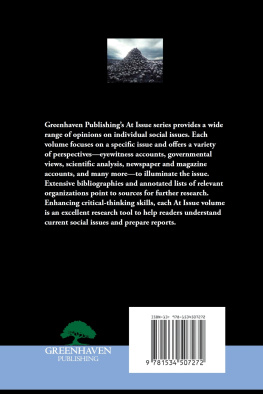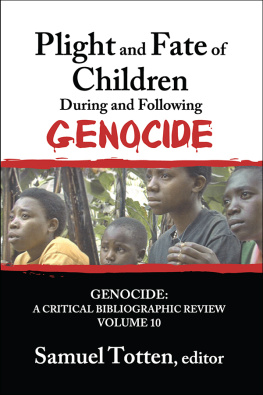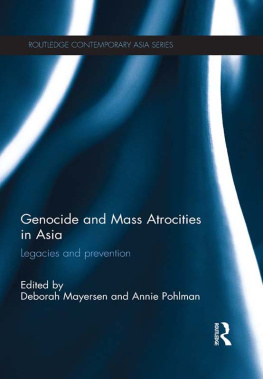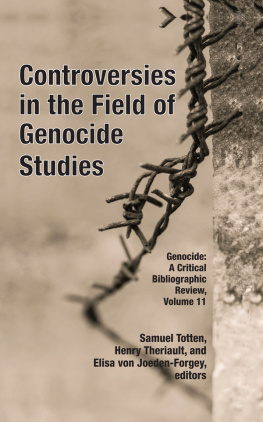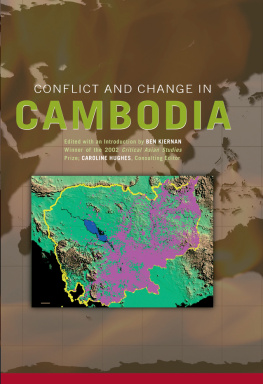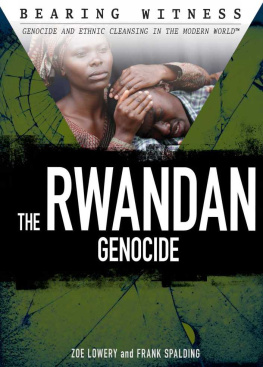BLOOD AND SOIL
OTHER BOOKS BY BEN KIERNAN
Peasants and Politics in Kampuchea, 19421981 (coauthor)
Revolution and Its Aftermath in Kampuchea (coeditor)
How Pol Pot Came to Power: Colonialism, Nationalism, and Communism in Cambodia, 19301975
Burchett: Reporting the Other Side of the World, 19391983 (editor)
Pol Pot Plans the Future: Confidential Leadership Documents from Democratic Kampuchea, 19761977 (coeditor)
Genocide and Democracy in Cambodia: The Khmer Rouge, the United Nations, and the International Community (editor)
The Pol Pot Regime: Race, Power, and Genocide in Cambodia under the Khmer Rouge, 19751979
Le gnocide au Cambodge, 19751979: Race, idologie et pouvoir
Conflict and Change in Cambodia (editor)
The Specter of Genocide: Mass Murder in Historical Perspective (coeditor)
Genocide and Resistance in Southeast Asia: Documentation, Denial, and Justice in Cambodia and East Timor
BLOOD AND SOIL
A World History of Genocide and Extermination from Sparta to Darfur
Ben Kiernan

The author has made his best efforts to secure permission for the use of all copyrighted images and material. Any rightsholders with questions are encouraged to contact the author care of Yale University Press.
Published with assistance from the Kingsley Trust Association Publication Fund established by the Scroll and Key Society of Yale College. Also published with assistance from the Mary Cady Tew Memorial Fund.
Copyright 2007 by Ben Kiernan.
All rights reserved.
This book may not be reproduced, in whole or in part, including illustrations, in any form (beyond that copying permitted by Sections 107 and 108 of the U.S. Copyright Law and except by reviewers for the public press), without written permission from the publishers.
Designed by James J. Johnson and set in Minion Roman types by
Tseng Information Systems, Inc., Durham, North Carolina.
Printed in the United States of America by
R.R. Donnelley, Harrisonburg, Virginia.
The Library of Congress has cataloged the hardcover edition as follows:
Kiernan, Ben.
Blood and soil : a world history of genocide and extermination
from Sparta to Darfur / Ben Kiernan.
p. cm.
Includes bibliographical references and index.
ISBN 978-0-300-10098-3 (cloth : alk. paper)
1. Genocide 2. Crimes against humanity. I. Title.
HV6322.7.K54 2007
304.663dc22
2007001525
ISBN 978-0-300-14425-3 (pbk. : alk. paper)
A catalogue record for this book is available from the British Library.
This paper meets the requirements of ANSI/NISO Z 39.48-1992 (Permanence of Paper).
It contains 30 percent postconsumer waste (PCW) and is certified by the Forest Stewardship Council (FSC).
10 9 8 7 6 5 4 3 2 1
For Glenda Elizabeth Gilmore
Contents
Maps
Introduction
At the beginning of the world, said the Portuguese Jesuit Manuel de Nbrega in 1559, all was homicide. This was a suspect but significant statement. From the sixteenth century, many Europeans began looking to ancient precedents, even for genocide, a phenomenon that had become more frequent after European expansion accelerated in 1492. A cult of antiquity inspired those on the brink of modernity even as they took up technological innovations, including some that facilitated mass murder.
Nbregas claim contained more than a grain of truth. Mass killing was no New World novelty. Some prehistorians suspect that ancestors of modern humans exterminated Europes archaic Neanderthal population. Later archaeological evidence suggests that during the Stone Age, competing local communities may have resorted even to annihilation of one another. Over 5,000 years ago, for example, Mesolithic hunter-gatherers in a region of what is now Germany carefully positioned the skulls of 34 men, women, and children in a cave. Archaeologists found these trophy skulls arranged in groups like eggs in a basket. Most bore evidence of multiple blows with stone axes.
The rise of agriculture in the Neolithic era supplied a surplus that could sustain systematic warfare. If Europes first farmers were more civilized than prehistoric hunters, ironically, well-provisioned agricultural societies may also have been more prone to mass killing. Evidence exists of the destruction of entire communities. Excavation at the early Neolithic site of Talheim in Germany revealed that 7,000 years ago, a group of killers armed with six axes massacred 18 adults and 16 children, then threw their bodies into a large pit. A
The prominence in genocidal ideology of cults of antiquity and a fetish for agriculture are two of the four major themes of Blood and Soil. Some ancient precedents reveal early preoccupations with land use. According to the Bible, for example, extreme violence often accompanied conflicts over land and sometimes pitted prospective farmers against ethnically alien town dwellers. While God promised the Israelites a good and spacious land, a land flowing with milk and honey (Exodus 3:8), the book of Deuteronomy added: Of the cities which the Lord thy God doth give thee for an inheritance, thou shalt save alive nothing that breatheth (20:16). The book of Joshua (610) describes Israelite massacres of the entire populations of seven cities, including Jericho and three Amorite kingdoms. Joshua smote all the country of the hills, and of the south, and of the vale, and of the springs, and utterly destroyed all that breathed (10:40; see ).
Animosity toward nonagriculturalistsnomadic, pastoral, or urbanizedmay have fueled some of the conflicts described in the Old Testament. One target of Deuteronomy were the Amorites, whom the Sumerians termed a pastoral people who do not grow grain. In more urbanized Canaan, the Israelite arrival apparently brought agricultural terracing and sedentarization to previously sparsely settled areas. The new devotion of the Israelitesheretofore pastoralists themselvesto agriculture may have intensified their ideological hostility to other pastoral peoples even as they clung to their own pastoral traditions.
Yet the biblical association of agriculture with righteousness was never pervasive; the pastoral image of the shepherd and flock remained more common until the fifteenth century. In the book of Genesis, Cain offered fruits of the soil, but God did not look with favor on them, accepting only Abels new lamb (4:34). Banished for killing Abel, Cain became the first peasant of ancient and medieval Christianity. Far from being favored, as historian Paul Freedman has shown, Cain signified the ur-peasantdeformed, rustic, and wicked. Biblical pastoralism and the medieval model of a pristine, idyllic garden both rejected the cultivator. Farming found relative ideological favor only in the modern era.
Some ancient sources also suggest a third recurring theme of genocide and thus of this book: ethnic enmity. The Old Testament is replete with examples. Deuteronomy trumpets hatred and violence: But thou shalt utterly destroy themthe Hittites, Amorites, Canaanites, Perizzites, Hivites and Jebusitesas the LORD your God has commanded you (20:17). Listing these same ethnic groups, the book of Exodus adds: I will wipe them out (23:23). Again in Deuteronomy we read: [T]hou shalt smite them, and utterly destroy them; thou shalt make no covenant with them, nor shew mercy unto them. Thou shalt consume all the people which the Lord thy God shall deliver thee; thine eye shall have no pity upon them (7:2, 16). Whatever this might reveal of actual biblical events, such extremism is neither limited to nor representative of Jewish texts, any more than the Korans injunction to slay the idolaters wherever you find them (9:5) is representative of Islamic texts. Jews in particular have long been major victims of ethnic persecution and slaughter; during the second millennium, it was often professed Christians who appealed to violent biblical injunctions as precedents for the mass murder of other groups.
Next page

